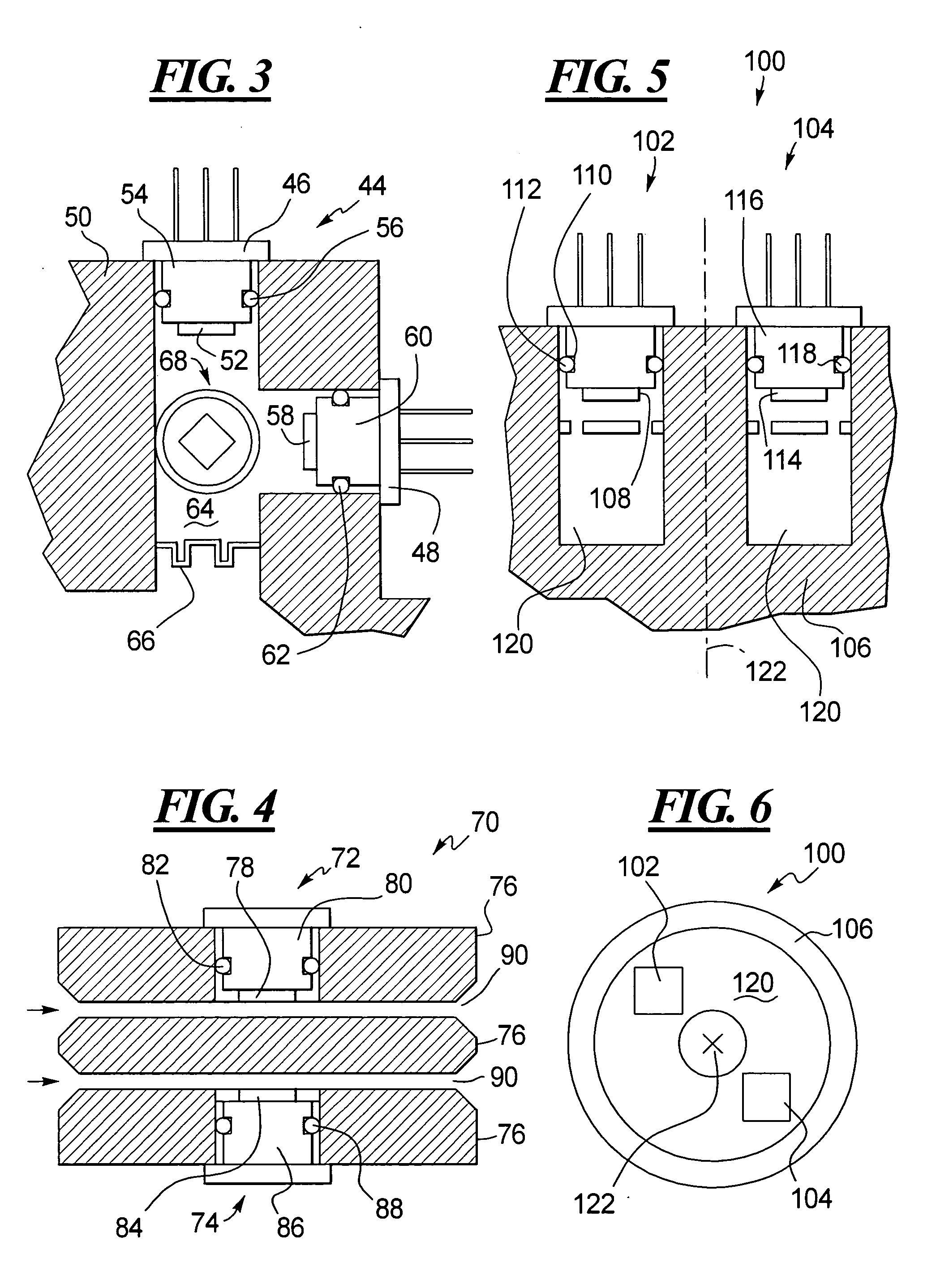Differetial thermal sensors
a technology of differential fluid properties and thermal sensors, applied in the direction of instruments, testing water, material analysis, etc., can solve the problems of undesired error components, two thermal conductivity sensors in this system may be exposed to different conditions, and achieve the effect of maximum differential fluid property measurement sensitivity and time resolution
- Summary
- Abstract
- Description
- Claims
- Application Information
AI Technical Summary
Benefits of technology
Problems solved by technology
Method used
Image
Examples
first embodiment
[0022]FIG. 1 shows an absolute thermal conductivity sensor 10 according to the present invention. As shown in FIG. 1, the absolute thermal conductivity sensor 10 includes a first microstructure sensor 12 and a second microstructure sensor 14 mounted to a housing 16.
[0023] The first microstructure sensor 12, for example, may comprise a first microstructure 18 supported by a first mounting block 20 secured to the housing 16. A first O-ring seal 22 fitted in a recess of the first mounting block 20 seals against leakage between the housing 16 and the first mounting block 20.
[0024] The second microstructure sensor 14, for example, may comprise a second microstructure 24 supported by a second mounting block 26 secured to the housing 16. A second O-ring seal 28 fitted in a recess of the second mounting block 26 seals against leakage between the housing 16 and the second mounting block 26.
[0025] Each of the first and second microstructures 18 and 24, for example, may be constructed in acc...
second embodiment
[0033]FIG. 3 shows an orientation sensor 44 according to the present invention. As shown in FIG. 3, the orientation sensor 44 includes a first microstructure sensor 46 and a second microstructure sensor 48 mounted to a housing 50.
[0034] The first microstructure sensor 46, for example, may comprise a first microstructure 52 supported by a first mounting block 54 secured to the housing 50. A first O-ring seal 56 fitted in a recess of the first mounting block 54 seals against leakage between the housing 50 and the first mounting block 54.
[0035] The second microstructure sensor 48, for example, may comprise a second microstructure 58 supported by a second mounting block 60 secured to the housing 50. A second O-ring seal 62 fitted in a recess of the second mounting block 60 seals against leakage between the housing 50 and the second mounting block 60.
[0036] Each of the first and second microstructures 52 and 58, for example, may be constructed in accordance with the microbridge disclos...
third embodiment
[0043]FIG. 4 shows a differential thermal conductivity sensor 70 according to the present invention. For example, the differential thermal conductivity sensor 70 can be used in gas chromatography. As shown in FIG. 4, the differential thermal conductivity sensor 70 includes a first microstructure sensor 72 and a second microstructure sensor 74 mounted to a housing 76.
[0044] The first microstructure sensor 72, for example, may comprise a first microstructure 78 supported by a first mounting block 80 secured to the housing 76. A first O-ring seal 82 fitted in a recess of the first mounting block 80 seals against leakage between the housing 76 and the first mounting block 80.
[0045] The second microstructure sensor 74, for example, may comprise a second microstructure 84 supported by a second mounting block 86 secured to the housing 76. A second O-ring seal 88 fitted in a recess of the second mounting block 86 seals against leakage between the housing 76 and the second mounting block 86...
PUM
| Property | Measurement | Unit |
|---|---|---|
| dead volume | aaaaa | aaaaa |
| absolute thermal conductivity | aaaaa | aaaaa |
| temperature | aaaaa | aaaaa |
Abstract
Description
Claims
Application Information
 Login to View More
Login to View More - R&D
- Intellectual Property
- Life Sciences
- Materials
- Tech Scout
- Unparalleled Data Quality
- Higher Quality Content
- 60% Fewer Hallucinations
Browse by: Latest US Patents, China's latest patents, Technical Efficacy Thesaurus, Application Domain, Technology Topic, Popular Technical Reports.
© 2025 PatSnap. All rights reserved.Legal|Privacy policy|Modern Slavery Act Transparency Statement|Sitemap|About US| Contact US: help@patsnap.com



